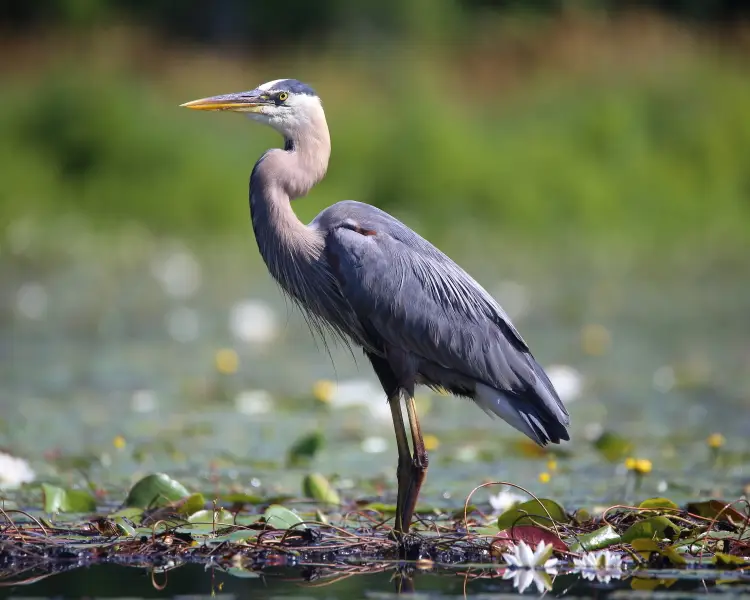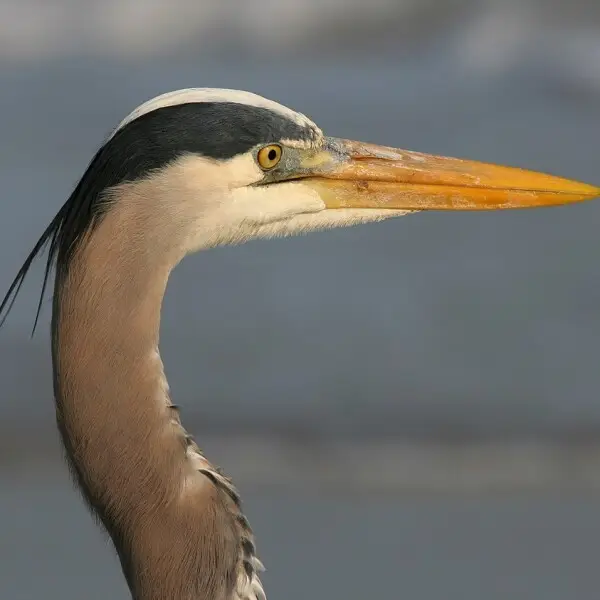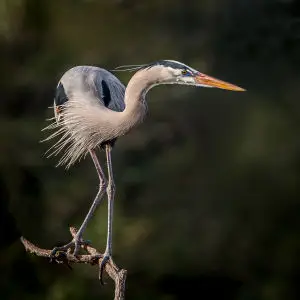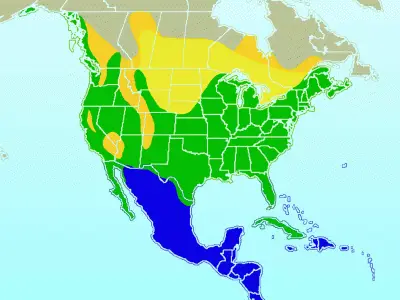Great Blue Heron Habitat Great Blue Heron Bird Fact



Great Blue Heron
Great White heron (southern Florida)
Population size
500,000-4,9M
The Great blue heron is a tall and statuesque bird when wading in the water seeking its prey, and it is graceful and swift when flying with its slow deep wing beats. It is one of the most majestic wild birds in North America. This stately bird has subtle blue-gray plumage and often stands motionless while it scans for prey or it wades belly deep using long, deliberate steps. It can strike rapidly to capture its prey.
Photos with Great Blue Heron





View 27 more photos of Great Blue Heron
Distribution
Geography
Antigua and Barbuda, Bahamas, Barbados, Belize, Canada, Colombia, Costa Rica, Cuba, Dominica, Dominican Republic, Show More Ecuador, El Salvador, Grenada, Guadeloupe, Guatemala, Honduras, Jamaica, Mexico, Nicaragua, Panama, Saint Kitts and Nevis, Saint Lucia, Saint Vincent and the Grenadines, Trinidad and Tobago, United States, Venezuela, Brazil, Cape Verde, France, Portugal, Spain Show Less
Great blue herons live in Nearctic and neotropical regions. In spring and summer, this species breeds throughout Central and North America, southern Canada, the Caribbean, and the Galapagos. They are mostly migratory, though some populations in the southern United States stay in one area year-round. Northern populations move to the south of the United States, or to Central or South America, as they cannot catch fish when the water is frozen. Great blue herons occur in many habitats including mangrove and salt marsh swamps, freshwater swamps and marshes, coastal lagoons, ditches, riverbanks, flooded meadows, and lake edges.

Biome
Climate zones

Habits and Lifestyle
These birds are active mainly in the mornings and during dusk when the fishing is best. They prefer to feed alone but loose feeding flocks may form sometimes as they are able to locate schools of fish more easily. At night the birds gather in flocks of more than 100 other herons. During the breeding season, Great blue herons become extremely territorial and defend their nests aggressively. They are a relatively quiet species and make a soft "kraak" if disturbed in flight or "fraunk" if disturbed near their nest. Their greeting to others of their species is an "ar" sound. They use up to 7 different sounds.
Diet and Nutrition
Great blue herons are carnivores (piscivores). They eat mainly fish, but also frogs, salamanders, snakes, lizards, young birds, small mammals, crabs, shrimp, crayfish, dragonflies, and grasshoppers, as well as many aquatic invertebrates.
Mating Habits
in the north: March-May, in the south: November-April
Great blue herons usually have one mate for the duration of the breeding season and then will choose a new mate in the following year, which means they exhibit a serial monogamous mating system. Males perform courtship displays in order to attract a female, including flight displays and posturing with their feathers fluffed up. The birds in the north of their range breed from March until May and November to April in the south. Males often arrive first at the breeding grounds and most of them will choose an existing nest for the season. However some males, mostly younger ones, will make a new nest. Great blue herons usually breed in colonies, in trees close to lakes or other wetlands. Colonies typically contain 5 to 500 nests, with an average per colony of 160 nests. 3 to 7 eggs are laid and incubation is shared by both parents, for about 28 days. The young remain in the nest for around 9 to 10 weeks. The chicks start to climb on branches near the nest at the end of week 7, and at week 9 they are able to make short flights. They become reproductively mature at about 22 months old.

Population
Population threats
The Great blue heron is abundant and widespread, and at species level is not subjected to any major threats. However, some populations, especially those in small areas near the coast, are vulnerable to such localized impacts as habitat destruction, human persecution and disturbance, pollution.
Population number
According to the IUCN Red List, the total population size of the Great blue heron is 500,000-4,999,999 mature individuals. Currently, this species is classified as Least Concern (LC) and its numbers today are Increasing
Ecological niche
Due to their diet, Great blue herons control fish and insect populations across a range of their native habitats. They may also affect predator populations (crows, ravens, eagles, raccoons, bears), as items of prey.
Fun Facts for Kids
- Herons are thought to have lived in the Cenozoic age, about 25 million years ago. Fossil records in North America date from 1.8 million years ago.
- Heron chicks have gray eyes when born but they become bright yellow when they are adults.
- Great Blue herons can swallow fish that are much wider than their narrow neck.
- Herons spend about 90 percent of their waking time stalking food.
- The feathers on a Great Blue heron's chest are highly specialized, like a powdery down, and continually grow and fray.
- Herons use their chest feathers for removing slime and oils from the rest of their plumage as they preen.
- These herons that live near the ocean often sit on plant material such as floating kelp waiting for fish to swim by.
References
More Fascinating Animals to Learn About
Source: https://animalia.bio/great-blue-heron

0 Response to "Great Blue Heron Habitat Great Blue Heron Bird Fact"
Post a Comment